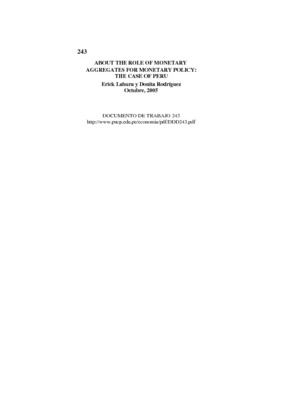| dc.contributor.author | Lahura, Erick | |
| dc.contributor.author | Rodríguez, Donita | |
| dc.date.accessioned | 2015-03-19T20:37:45Z | |
| dc.date.available | 2015-03-19T20:37:45Z | |
| dc.date.issued | 2005 | |
| dc.identifier.uri | http://repositorio.pucp.edu.pe/index/handle/123456789/46883 | |
| dc.description.abstract | El propósito principal de la presente investigación es analizar la relevancia de los agregados monetarios para la política monetaria como indicadores de la actividad económica real. La principal hipótesis de este trabajo es que los agregados monetarios más líquidos ayudan a predecir el producto real. El análisis empírico combina la descomposición de las series de tiempo usando funciones “wavelet” y la posible existencia de relaciones de cointegración entre dinero, producto y precios. Usando datos recientes para la economía peruana, se encuentra evidencia a favor de la hipótesis planteada. En particular, los resultados sugieren la existencia de co-integración entre series no estacionarias construidas a partir de funciones wavelets. En este contexto, las pruebas de exogeneidad revelan que los agregados monetarios más líquidos son débil y fuertemente exógenos, y por lo tanto ayudan a predecir el producto real. Estos resultados sugieren que el dinero puede ser útil para la política monetaria como indicador de la actividad económica real. | es_ES |
| dc.description.abstract | The purpose of this paper is to analyze the relevance of monetary aggregates for monetary policy as indicators of real activity. The main hypothesis of this paper is that narrow monetary aggregates can help forecasting real output. The empirical analysis combines the time scale decomposition of time series using wavelets and the possible existence of cointegrating relationships between money, output and prices. Using recent Peruvian data, evidence is found to support the proposed hypothesis. In particular, the results suggest the existence of co-integration between non-stationary series built using wavelet filtering. In this context, exogeneity tests reveal that narrow monetary aggregates are weakly and strongly exogenous; i.e., they are helpful for forecasting real output. These results suggest that money has a role for monetary policy as an indicator of real activity. | en_US |
| dc.language.iso | spa | es_ES |
| dc.publisher | Pontificia Universidad Católica del Perú. Centro de Investigaciones Sociológicas, Económicas, Políticas y Antropológicas - CISEPA | es_ES |
| dc.relation.ispartofseries | Documento de Trabajo;243 | es_ES |
| dc.rights | Atribución-NoComercial-SinDerivadas 2.5 Perú | * |
| dc.rights | info:eu-repo/semantics/openAccess | es_ES |
| dc.rights.uri | http://creativecommons.org/licenses/by-nc-nd/2.5/pe/ | es_ES |
| dc.subject | Política monetaria--Perú | es_ES |
| dc.title | About the role of monetary aggregates for monetary policy: the case of Peru | es_ES |
| dc.title.alternative | Acerca del rol de los agregados monetarios en la política monetaria: El caso del Perú. | es_ES |
| dc.type | info:eu-repo/semantics/workingPaper | |
| dc.type.other | Documento de trabajo | |
| dc.subject.ocde | http://purl.org/pe-repo/ocde/ford#5.02.00 | |
| dc.publisher.country | PE | |
| renati.advisor.orcid | https://orcid.org/0000-0001-9199-4677 | |


